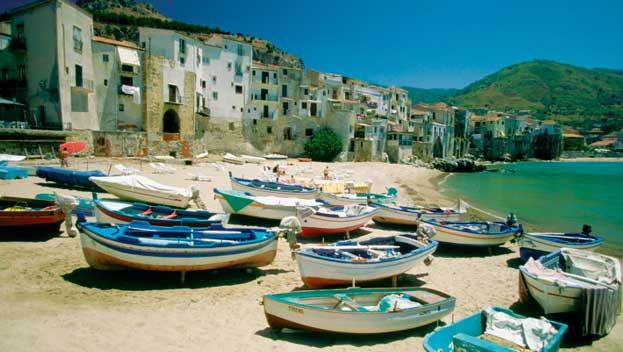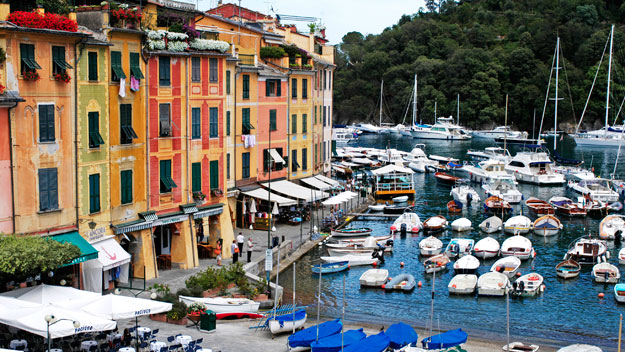Across the Strait of Messina from mainland Italy is the sun-drenched island of Sicily with its glorious sandy beaches, aquamarine coves, ancient ruins and Mt Etna, Europe’s most volatile volcano that most recently erupted in May 2007.
Its history is as colourful as its fabulous coastline, where Roman ruins, Norman castles and tiny villages cling like limpets to rock platforms on top of cliffs.
A home away from home for restless Greeks in antiquity, Sicily experienced Roman domination and its own renaissance under the enlightened rule of the Moors during the Middle Ages, only to become a pirate haunt and, much later, a headquarters to the Italian mafia.
Covered in vineyards and olive groves, its fertile volcanic soil produces some of Europe’s most succulent and tasty fruit and vegetables. Couple this with fabulous seafood and you soon discover the island has its own rich and irresistible blend of Mediterranean cuisine.
It’s the perfect destination to spend time lazing on the beach before exploring some of the island’s Roman amphitheatres, Greek temples and old pirate haunts hidden away in cathedral-like sea grottos.

Sicilian palace
Seven top places to visit
Palermo
Sicily’s capital is a little shabby — some might even say seedy in some of the poorer parts around the port — but its centre has a faded baroque splendour as dignified as it is decrepit.
A civilised way to get here, after visiting the Amalfi Coast on the mainland, is by overnight ferry from Naples (departs 8.15pm, arrives 6.30am). Get a sleeper cabin and enjoy dinner in the dining room or the cafeteria.
Explore the centre of the old town, around Quattro Canti (Four Corners), then move on to the 12-century Norman Palace, King Roger II’s Royal Chapel (Cappella Palatina) and the Norman district known as the Albergheria.
Don’t miss the Cathedral on the Corso Vittorio Emanuele, the Sant Agostino monastery and the neo-classical Massimo Theatre.
You could spend a week exploring Palermo’s countless churches, but one you shouldn’t miss is the tiny Chiesa di San Cataldo, a former mosque converted by the Normans into a church.
North of Palmero, on top of a mountain overlooking the city, is the massive Monreale Cathedral, a place of pilgrimage, where you can take in the whole city of Palermo.
Cefalú
Two hours on the autostrada east of Palermo is Cefalú, a former fishing village with a charming sea front and medieval centre, but now sadly swamped by modern suburbs. Visit early — before the traffic jams — and take a stroll along the beach for half a kilometre where, looking back, you’ll get a great photo of the old town. Have an early lunch in a restaurant overlooking the Tyrrhenean Sea, where you can make out the silhouettes of the Aeolian Islands in the distance before heading further east to Taormina.
Taormina
This old Roman city sits on a high terrace dominating the sea and has spectacular views west towards Mt Etna. Known as one of the most beautiful natural settings in Italy, it can be best appreciated from the Roman theatre, perched on a rocky outcrop 350 metres above the sea.
From this eagle’s eyrie, the sea sweeps to the horizon in front of you, while in the other direction, the city unfolds as a series of undulating slopes, giving way to vineyards and eventually to the vast bulk of Mt Etna on the northern horizon.
Perched above two coves, Taormina has a cable car that descends into the Bay of Mazzaro, a useful connection — as beach lovers will soon discover if they undertake the arduous walk from cliff top to sand.
One particularly charming restaurant, Il Barcaiolo, is nestled on the edge of the Bay of Mazzaro. Surrounded by lapping water and fishing boats, it serves ocean-fresh seafood dishes under an arbour of grape vines.
Offshore in the other cove is Isola Bella (Beautiful Island), famous for its mysterious villa and garden occasionally open to the public.
Syracuse
Further south, and overlooking the Ionian Sea, is the island town of Syracuse, a former war-mongering Greek city-state founded in 700BC which is now a tranquil backwater joined to the mainland by two bridges.
The Greek ruins on the edge of town are disappointing unless you’re an archaeologist. More fascinating is the medieval old town on the island, known as Ortigia, with its piazzas and magnificent Venetian villas.
At the Piazza Duomo, you’ll find the city’s cathedral, a fascinating medieval structure built around the Greek Temple of Minerva. The massive Doric columns can still be seen inside the building and line its exterior like the ribs of an ancient whale.
Stay in a small hotel in the old town and dine at a seafood trattoria overlooking the sea at the southern tip of Ortigia.
Noto
An hour’s drive inland from Syracuse is the extraordinary town of Noto, built by a group of nobles after the old town was flattened by an earthquake in 1693.
Like a stately wedding cake with golden icing, it sits in the parched interior, the finest and most coherently baroque town in Italy and maybe the world. It’s as if time stopped when they completed building the city in 1700. Nothing appears to have been added or taken away.
Since it was put on UNESCO’s World Heritage List, its palaces, fountains and piazza’s — all made of soft golden limestone — have been restored.
Noto has been called an outdoor architectural museum and makes for a fascinating half-day excursion from Syracuse.
Agrigento
Another ancient Greek colony, Agrigento has been attracting tourists to Sicily’s south-west coast since the German literary giant Goethe put it on the map in the 18th century.
Its chief attraction is the Valley of the Temples, where five Doric temples stand along a ridge, sadly now overshadowed by towering apartment blocks on the hill above. Come during March and April — when the surrounding meadows fill with wildflowers — and keep your back to the ugly modern city as you explore this magnificent site.
Castellammare Del Golfo
This unspoilt fishing village — half an hour’s drive west of Palermo — is the perfect destination to spend your first (or last) night on the island. Connected to the international airport by an autostrada, it takes just 20 minutes to get there after leaving the terminal — making it the perfect destination for travellers arriving late in the evening or leaving early in the morning.
Several seafood restaurants overlook the town’s sandstone harbour, where a little fleet of blue and white fishing boats are moored. The sea around Castellammare is brilliant turquoise and seems to glow under the slate grey rocky peaks of the surrounding mountains.
Half an hour away by car, in a perfect pastoral setting, is the Temple of Segesta, built by the survivors of those who fled the destruction of ancient Troy.


